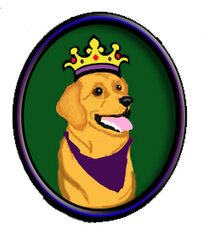BARF - The Pro Side

In keeping with the spirit of my blog title, “You’re feeding me WHAT?”, I find the topic and title of this entry slightly amusing. I am talking about the complete opposite of the commercial pet food diet. What is this alternative diet called?
BARF.
Yep, you heard me. BARF. Sounds yummy, huh? Ugh.
Okay, seriously…What is the BARF diet? BARF is an acronym for Bones And Raw Food, or Biologically Appropriate Raw Food. Not quite as gross as it sounded!
What does the BARF diet consist of? Why is it different? I will present a very much condensed crash course in the pros and cons of the BARF diet. There are many staunch supporters of this diet, but there are just as many the vehemently oppose it. I will try to show both sides here. This article will address the PRO side of BARF.
First of all, what is wrong with commercial pet food? Well, if you’ve been reading my blog from the beginning (if not, I recommend that you do) you know there is a LOT wrong with most commercial foods. Most grocery store brands and even a lot of the so-called premium brands of kibble are full of ingredients I would never feed my pet. Keep in mind that the claim of “nutritionally balanced and complete” only means that the food will sustain life. Period. Beyond that, it means pretty much nothing.
Many commercial pet foods contain a lot of grains such as corn, wheat or rice (things that cats and dogs do not eat in the wild). They may also contain additives and preservatives that are not at all healthy, or necessary, for pets. Digestion should start in the mouth when saliva mixes with chewed-up food, but most kibble is small and some pets end up swallowing it whole.
The BARF diet aims to replicate a diet similar to what a wolf would eat in the wild. This diet is not typically accepted by many veterinarians, and there are few scientific studies on it, at least that I am aware of. Supporters of raw feeding believe that the natural diet of an animal in the wild is what it is most adapted to. They try to duplicate this diet for their pet, with the belief that a balanced raw diet has the benefits of giving the animal a healthier coat, cleaner teeth and breath, reduced stool volume and odor, and better overall health.
Let’s take a look at exactly what the BARF diet includes. (..more)
A typical BARF diet is made up of 60-80% of raw meaty bones (RMB), that is bones with about 50% meat, (e.g. chicken neck, back and wings) and 20-40% of fruits and vegetables, offal, meat, eggs, or dairy foods. A sample BARF meal may include things like raw chicken necks or backs, raw chicken wings, organ meats (a few times a week), ground raw veggies and fruits, ground meat, and whole eggs (including shells). The food is supplemented with flax or fish oil, probiotics, and any sort of supplement that includes vitamins and trace minerals.
Are raw meats safe for my pet? Most pet owners and holistic veterinarians report no obvious health problems in pets fed raw meat. Many owners and doctors report healthier looking coats and skin, less itching, less arthritis, and general overall health improvement once pets are slowly switched from processed food and fed raw homemade diets. There are health concerns with feeding raw meat, including parasites and bacterial contamination, which we will take a look in the next section.
BARF does take a commitment to understanding basic canine nutrition. The main drawback to preparing diets at home is that unless following properly formulated recipes, it is easy to create nutrient deficiencies or excesses that could cause illness in your pet.
The idea behind the homemade diets is that the owner will use fresh, minimally processed ingredients. By offering fresh food, there are more nutrients in the diet that would otherwise be removed as a result of processing. Homemade diets seek to emphasize freshness and wholesomeness of ingredients. The diets avoid the harmful chemical preservatives, additives, and artificial colorings and flavors that may occur in some commercially prepared diets. Homemade diets are designed to address common concerns owners may express concerning commercial pet foods.
Pet owners have often been told, "don't feed your pet people food," but this advice is erroneous for two reasons. First, processed dog food and cat food is nothing more than "people food" processed into pellets and put in a bag for pets (although many manufacturers use ingredients not fit for human consumption.) Second, prior to the origin of processed foods in the early 1900's, our pets ate nothing but people food (unless the dog or cat hunted its own meals.) Many holistic veterinarians think that the diseases we now see (diseases such as immune disorders, allergies, and arthritis that were rare in past years) are a direct result of processed pet foods.
Some of the main points made by proponents of the BARF diet are:
- Fresh foods prepared at home with minimal processing provide phytonutrients (nutrients found in plants) such as bioflavonoids and many nutrients not yet discovered in the plants.
- The homemade diets use higher quality protein and carbohydrate sources and do not require heating to extremely high temperatures and extruding into pellets under high pressure like processed pet foods. This heating and pressurizing of food destroys most of the nutrients (enzymes, healthy bacteria (probiotics), and vitamins and minerals) that your pet requires, forcing pet food manufacturers to add extra vitamins and minerals to the food after extensive processing of the food (most manufacturers do not add back probiotics or enzymes; supplementation with these ingredients is still necessary to achieve levels found in homemade diets.
- Dogs and cats are mainly carnivorous and should be fed mainly meat-based diets when possible, although many commercial foods base their diets on cereal grains and vegetables.
- For owners who desire to feed a more natural, chemical-free diet, preparing diets at home is easy and cost-effective. You can select the freshest ingredients available; ideally the vegetables and meats should be organic (from plants and animals raised without chemicals, hormones, or pesticides.)
- Many commercial pet foods contain materials, including cereal grains, that pets are not designed to eat. Additionally, the quality of the ingredients, unless they are human quality ingredients, is low. In some processed foods (especially soft-moist "burgers,") sugars are used as the carbohydrate source. This may contribute to diabetes; excess sugar is not digested and can cause diarrhea. Propylene glycol, a preservative in soft-moist diets, can cause anemia, especially in cats.
For now, that’s all the “food for thought” until next time.
Print Page













































No comments:
Post a Comment